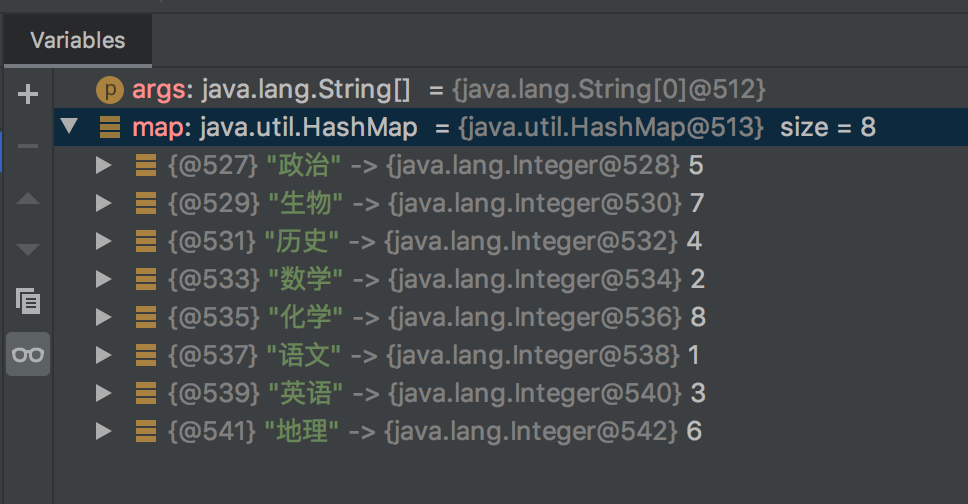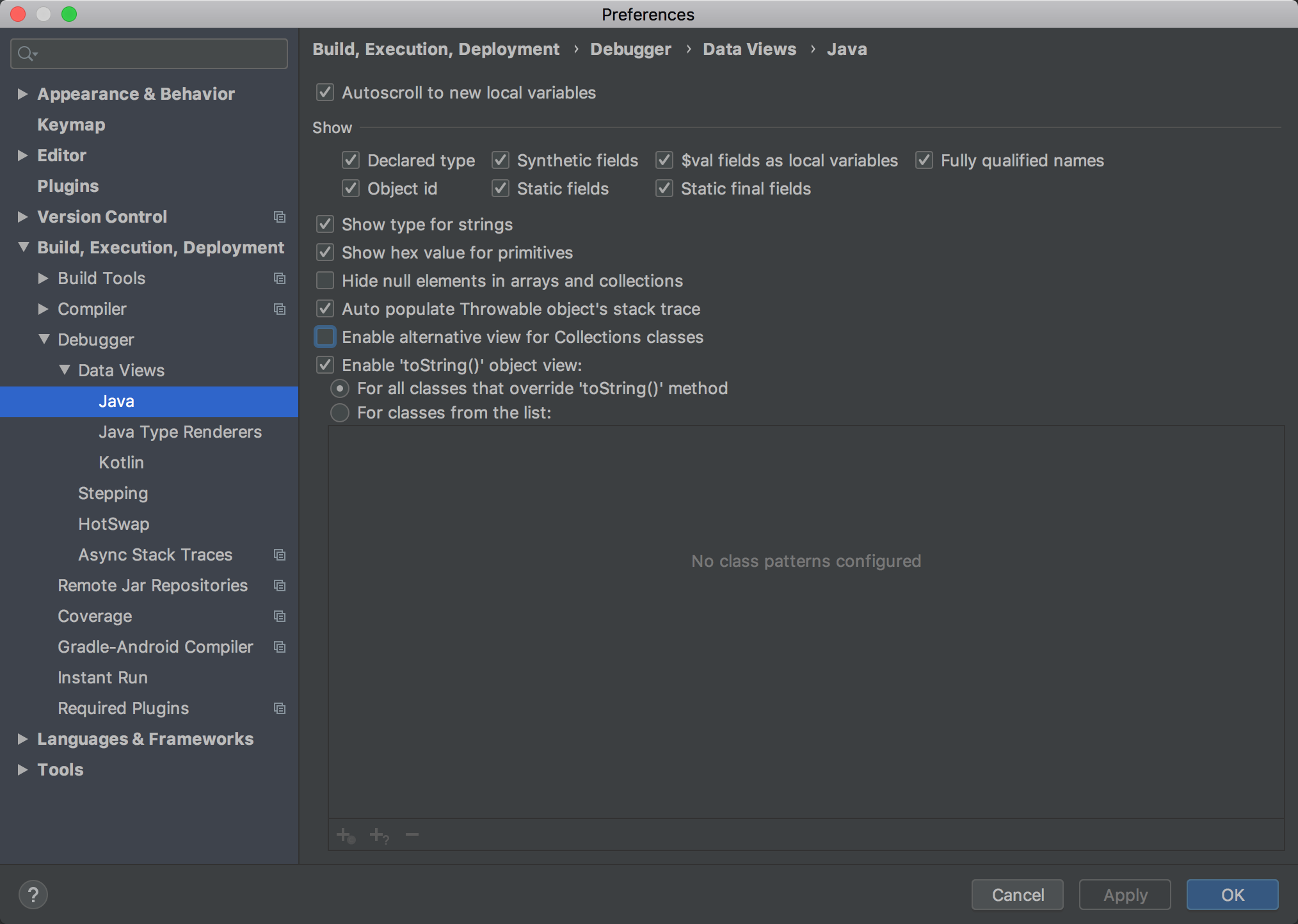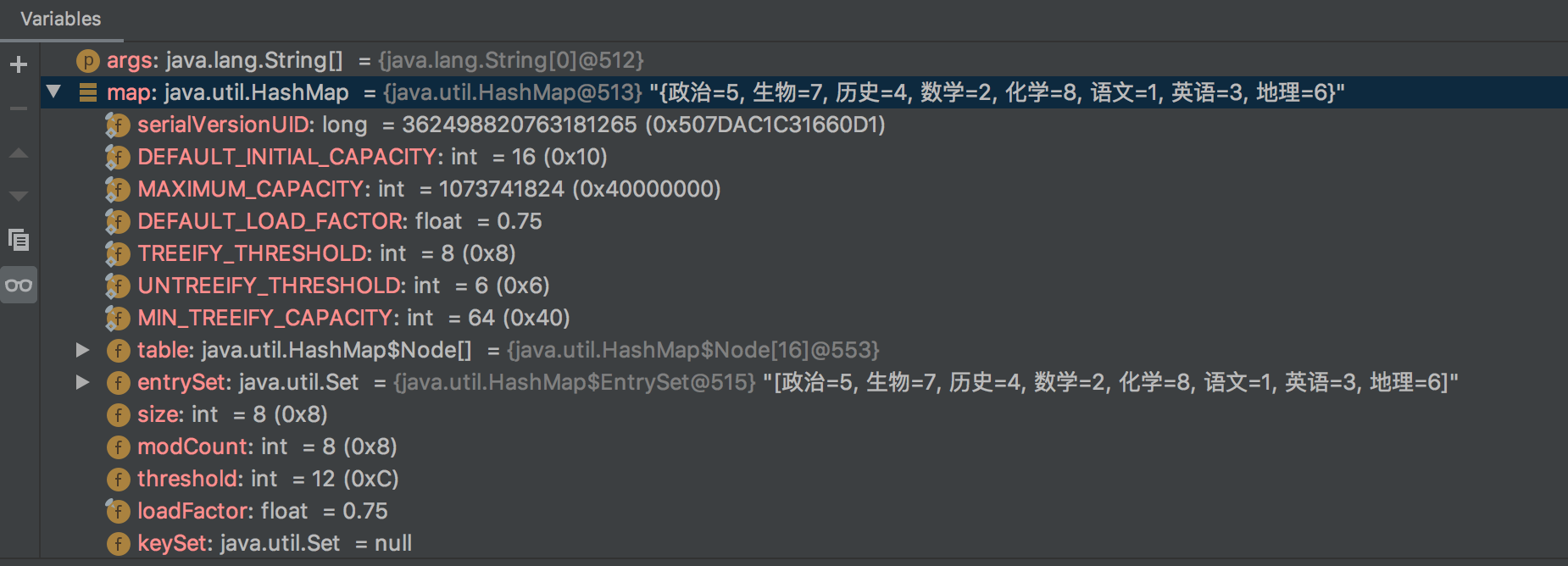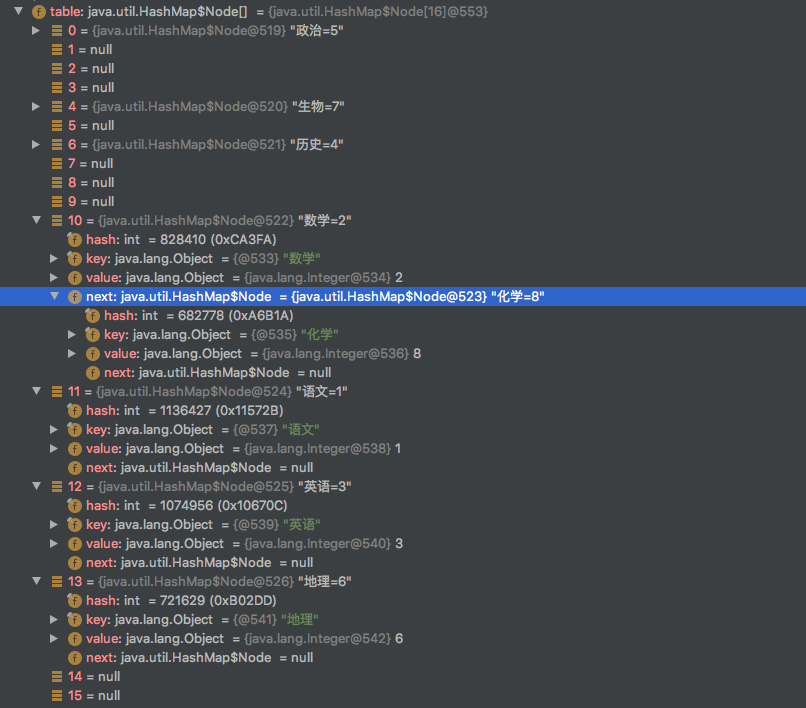这是一个面试经常会问到的问题。
底层原理是数组和链表,JDK 8以后添加了红黑树。
了解原理前,需要先了解以下概念:
hashCode, equals, 取模运算, 数组, 链表, 还有一些位运算
工具
分析原理最好使用能查看堆栈信息的工具,我这里用了idea的debug功能。如果你直接使用idea的debug是无法直接查看真实的map,因为idea为了更加直观的展示map中的数据,做了专门的优化,一开始你看的是这样的:

我们需要修改一下设置,在settings中搜索debug,找到data views->java, 然后可以看到这个,我们需要把那个Enable alternative view for Collections classes 关掉,这样就可以看到map的真是结构了。


hashMap分析
我们最常用的就是put方法,向hashMap中put数据。
HashMap<String, Integer> map = new HashMap<String, Integer>();
map.put("语文", 1);
map.put("数学", 2);
map.put("英语", 3);
map.put("历史", 4);
map.put("政治", 5);
map.put("地理", 6);
map.put("生物", 7);
map.put("化学", 8);
for (Map.Entry<String, Integer> entry : map.entrySet()) {
System.out.println(entry.getKey() + ": " + entry.getValue());
}我们来看一下内存的情况:

Node
我们发现数据都存在了一个table的数组里,table的声明为:transient Node, 它是一个数组,数组的类型为Node。我们来看一下:
static class Node<K,V> implements Map.Entry<K,V> {
final int hash; // 是指Key的hash值,算法是key的hashCode高16位与低16位相与,为了降低hash冲突、碰撞
final K key;
V value;
Node<K,V> next; // next,为链表的特性
Node(int hash, K key, V value, Node<K,V> next) {
this.hash = hash;
this.key = key;
this.value = value;
this.next = next;
}
public final K getKey() { return key; }
public final V getValue() { return value; }
public final String toString() { return key + "=" + value; }
public final int hashCode() {
return Objects.hashCode(key) ^ Objects.hashCode(value);
}
public final V setValue(V newValue) {
V oldValue = value;
value = newValue;
return oldValue;
}
public final boolean equals(Object o) { // 会比较k v的equals
if (o == this)
return true;
if (o instanceof Map.Entry) {
Map.Entry<?,?> e = (Map.Entry<?,?>)o;
if (Objects.equals(key, e.getKey()) &&
Objects.equals(value, e.getValue()))
return true;
}
return false;
}
}resize()
上边看到table的大小为16,这里是为什么呢?通过查找赋值过程,我找到了resize方法:
final Node<K,V>[] resize() {
Node<K,V>[] oldTab = table;
int oldCap = (oldTab == null) ? 0 : oldTab.length;
int oldThr = threshold;
int newCap, newThr = 0;
if (oldCap > 0) {
// 超过最大值就不再扩充了,就只好随你碰撞去吧
if (oldCap >= MAXIMUM_CAPACITY) {
threshold = Integer.MAX_VALUE;
return oldTab;
}
// 没超过最大值,就扩充为原来的2倍
else if ((newCap = oldCap << 1) < MAXIMUM_CAPACITY &&
oldCap >= DEFAULT_INITIAL_CAPACITY)
newThr = oldThr << 1; // double threshold
}
else if (oldThr > 0) // initial capacity was placed in threshold
newCap = oldThr;
else { // zero initial threshold signifies using defaults
newCap = DEFAULT_INITIAL_CAPACITY; // 默认16
newThr = (int)(DEFAULT_LOAD_FACTOR * DEFAULT_INITIAL_CAPACITY); // 0.75*16 = 12 触发扩容的临界值
}
if (newThr == 0) {
float ft = (float)newCap * loadFactor;
newThr = (newCap < MAXIMUM_CAPACITY && ft < (float)MAXIMUM_CAPACITY ?
(int)ft : Integer.MAX_VALUE);
}
threshold = newThr; // 触发扩容的临界值
@SuppressWarnings({"rawtypes","unchecked"})
Node<K,V>[] newTab = (Node<K,V>[])new Node[newCap]; // 创建table
table = newTab;
if (oldTab != null) { // 迁移旧table数据
for (int j = 0; j < oldCap; ++j) {
Node<K,V> e;
if ((e = oldTab[j]) != null) {
oldTab[j] = null; // 释放内存
if (e.next == null)
newTab[e.hash & (newCap - 1)] = e; // 与table大小-1相与,得到新的index
else if (e instanceof TreeNode) // 拆分树形的node
((TreeNode<K,V>)e).split(this, newTab, j, oldCap);
else { // preserve order // 拆分链表形的node
Node<K,V> loHead = null, loTail = null;
Node<K,V> hiHead = null, hiTail = null;
Node<K,V> next;
do {
next = e.next;
if ((e.hash & oldCap) == 0) { // 这种情况下,node还在原来的index下
if (loTail == null)
loHead = e;
else
loTail.next = e;
loTail = e;
}
else { // 这种情况下,node还在原来的index+j下
if (hiTail == null)
hiHead = e;
else
hiTail.next = e;
hiTail = e;
}
} while ((e = next) != null);
if (loTail != null) {
loTail.next = null;
newTab[j] = loHead;
}
if (hiTail != null) {
hiTail.next = null;
newTab[j + oldCap] = hiHead;
}
}
}
}
}
return newTab;
}以上就是table的创建以及扩容的过程,我们可以看到默认大小是16,扩容是以二倍的方式去扩容的,而开始扩容的时机为达到容量的0.75。
扩容过程中,会把就数据复制到新的table中,这里分为三种情况:node无next、next为树形、next为链式。
put()
我们在看一下put的实现:
public V put(K key, V value) {
return putVal(hash(key), key, value, false, true);
}
/**
* Implements Map.put and related methods
*
* @param hash hash for key
* @param key the key
* @param value the value to put
* @param onlyIfAbsent if true, don't change existing value 如果为true,这不会改变现有值
* @param evict if false, the table is in creation mode.
* @return previous value, or null if none
*/
final V putVal(int hash, K key, V value, boolean onlyIfAbsent,
boolean evict) {
Node<K,V>[] tab; Node<K,V> p; int n, i; // n为table大小
if ((tab = table) == null || (n = tab.length) == 0)
n = (tab = resize()).length; // 创建新的table
if ((p = tab[i = (n - 1) & hash]) == null) // 获取index,并将index位置的node赋给p, (n - 1) & hash 会得到一个0~(n-1的数),其实可以理解成hash%(n-1)
tab[i] = newNode(hash, key, value, null); // 该index下 无数据,直接赋值
else {
Node<K,V> e; K k;
if (p.hash == hash &&
((k = p.key) == key || (key != null && key.equals(k)))) // 存在相同的key,接下来会进行替换
e = p;
else if (p instanceof TreeNode) // 头部节点为树
e = ((TreeNode<K,V>)p).putTreeVal(this, tab, hash, key, value);
else { // 头部节点为链表
for (int binCount = 0; ; ++binCount) {
if ((e = p.next) == null) {
p.next = newNode(hash, key, value, null); // 新建node 插入尾部
if (binCount >= TREEIFY_THRESHOLD - 1) // -1 for 1st
treeifyBin(tab, hash); // >=7时,转换为树
break;
}
if (e.hash == hash &&
((k = e.key) == key || (key != null && key.equals(k)))) // key相同,更新value
break;
p = e;
}
}
if (e != null) { // existing mapping for key
V oldValue = e.value;
if (!onlyIfAbsent || oldValue == null)
e.value = value;
afterNodeAccess(e); // linkedHashmap利用这个排序
return oldValue;
}
}
++modCount;
if (++size > threshold)
resize(); // 是否需要扩容
afterNodeInsertion(evict); // linkedHashmap利用这个排序
return null;
}get()
当我们从hashMap中获取key对应的对象时,需要用的get方法
public V get(Object key) {
Node<K,V> e;
return (e = getNode(hash(key), key)) == null ? null : e.value;
}
final Node<K,V> getNode(int hash, Object key) {
Node<K,V>[] tab; Node<K,V> first, e; int n; K k;
if ((tab = table) != null && (n = tab.length) > 0 &&
(first = tab[(n - 1) & hash]) != null) {
// 直接命中
if (first.hash == hash && // always check first node
((k = first.key) == key || (key != null && key.equals(k))))
return first;
// 未命中
if ((e = first.next) != null) {
// 在树中get
if (first instanceof TreeNode)
return ((TreeNode<K,V>)first).getTreeNode(hash, key);
// 在链表中get
do {
if (e.hash == hash &&
((k = e.key) == key || (key != null && key.equals(k))))
return e;
} while ((e = e.next) != null);
}
}
return null;
}总结
如何确定存进来的对象的位置
首先,会对key的hashCode方法进行运算,生成一个新的hash,这个运算方法为:(key == null) ? 0 : (h = key.hashCode()) ^ (h >>> 16);即使用hashCode的高16与低16位相与。我们知道hashCode为int类型,int占4个字节,也就是4 * 8 = 32位。得到新的hash后,通过(n - 1) & hash得到在数组中的位置。
如果这个位置上没有东西,则直接赋值过去,
如果有东西:- 会先判断是不是相同的key,如果key相同则替换value
- 是否为红黑树,进行红黑树的操作,新增或者替换
- 是否为链表,进行链表的操作,新增或者替换
链表转为红黑树的条件
如果一个链表的长度超过了TREEIFY_THRESHOLD = 8;, 那么就会将这个链表转成红黑树table的扩容过程
默认情况下,table的初始大小为DEFAULT_INITIAL_CAPACITY = 16, 扩容因子为DEFAULT_LOAD_FACTOR = 0.75f, 当map的size达到了table.length * 扩容因子时,就会触发扩容。扩容时,table会变成原来的2倍,table中的数据也会重新计算位置。
参考
https://www.bilibili.com/video/BV1Pp411d7kB
https://yikun.github.io/2015/04/01/Java-HashMap%E5%B7%A5%E4%BD%9C%E5%8E%9F%E7%90%86%E5%8F%8A%E5%AE%9E%E7%8E%B0/
https://zhuanlan.zhihu.com/p/31610616
HashMap在多线程下的问题
使用HashMap真的发生线程安全问题,会造成什么后果?
- 可能造成死循环,多线程同时对线程进行put时,如果正好触发了扩容机制,这时可能会在扩容时产生一个环形链表,这时在get时会造成无限循环。
- 多线程进行put,如果正好发生了Hash碰撞,可能导致元素覆盖丢失的情况。
替换方案
使用HashTable或者ConcurrentHashMap进行替换。HashTable的安全的原理是对读写方法加了Synchronized关键字,保证只有一个线程可以对HashTable进行读写操作,从而实现了线程安全。这种方式效率较低,是不推荐使用的。ConcurrentHashMap是通过Synchronized代码块实现的线程安全,Synchronized锁的对象为HashMap中的Hash数组的Key值,也就是说对于Hash碰撞这种情况下,会通过锁将这个链表或者红黑树锁住,防止多线程同时读写该结构,但是在Hash没有发生碰撞的情况下,多个线程对不同的链表或者红黑树读写是不会受锁的限制,这样既保证了一定的效率,又保证了线程安全。
本博客所有文章除特别声明外,均采用 CC BY-SA 4.0 协议 ,转载请注明出处!